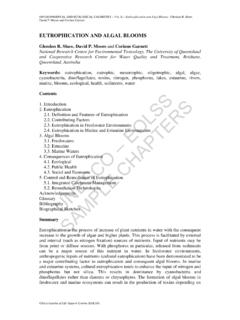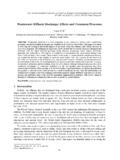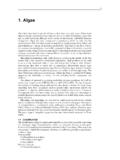Transcription of Cyanobacteria - cen.ulaval.ca
1 Cyanobacteria W F Vincent, Laval University, Quebec City, QC, Canada 2009 Elsevier Inc. All rights reserved. Introduction Spanish) because of their algal-like appearance, their possession of chlorophyll rather than bacteriochloro- Cyanobacteria are photosynthetic prokaryotes that phyll, and their photosynthetic production of oxygen capture sunlight for energy using chlorophyll a and by a two-photosystem process as in algae and higher various accessory pigments. They are common in plants. The most widely used taxonomic schemes for lakes, ponds, springs, wetlands, streams, and rivers, these organisms are largely based on the Interna- and they play a major role in the nitrogen, carbon, and tional Botanical Code, with separation according to oxygen dynamics of many aquatic environments.
2 The classic morphological criteria. Ultrastructural studies, exact timing of appearance of the first Cyanobacteria - however, clearly show that the Cyanobacteria are like microbes on Earth is still unclear because of prokaryotic; that is, they lack nuclei and other orga- controversy over the interpretation of Precambrian nelles and they have a peptidoglycan cell wall that fossils; however, much of their present diversity was is typical of gram-negative Eubacteria. They also achieved more than 2 billion years ago, and they likely possess several features that set them apart from played a major role in the accumulation of oxygen other bacteria, especially their photosynthetic appa- in the Earth's early atmosphere.
3 In addition to their ratus and oxygen production. The term blue-green remarkably long persistence as free-living organisms, algae' is still widely used by the media and in the Cyanobacteria also form symbiotic associations with water quality management area. The current taxo- more complex biota; for example, the nitrogen-fixing nomic separation of species, especially the coccoid species Anabaena (or Nostoc) azollae forms a symbi- and nonheterocystous (see definition later) taxa, is otic association with the floating fern Azolla, which believed to be artificial and not reflective of evolu- is widely distributed in ponds and flooded soils.
4 The tionary relationships, and will likely be substantially chloroplasts in plants and algae appear to be originally revised as more genetic data become available. derived from an endosymbiosis in which a cyanobacte- All Cyanobacteria contain chlorophyll a and most rium was engulfed and retained within a colorless contain the blue phycobiliproteins phycocyanin and eukaryotic cell. allophycocyanin, giving the cells their characteristic Modern-day Cyanobacteria include some 2000 spe- blue-green color. Many taxa also contain the phyco- cies in 150 genera and 5 orders (Table 1), with a great biliprotein phycoerythrin, making the cells red, or variety of shapes and sizes.
5 Ecologically, there are three sometimes black. The phycobiliproteins are located major groups in the aquatic environment: mat-forming in structures called phycobilisomes on the thylakoid species, which form periphytic biofilms over rocks, (photosynthetic) membranes, and these are highly effi- sediments, and submerged plants; bloom-formers, cient light guides' for the transfer of captured solar which create a wide range of water quality problems energy (excitation energy) to the reaction centers of and that are most common in nutrient-rich (eutrophic). photosynthesis, specifically photosystem II. A group lakes; and picocyanobacteria, which are extremely of photosynthetic microbes formally classified as a small cells (<3 mm in diameter) that are often abundant separate prokaryotic phylum, the Prochlorophyta, in clear water lakes.
6 Additional groups include colonial contains chlorophyll b in addition to a, but lacks non-bloom-formers, which are common in a variety of phycobiliproteins and thus phycobilisomes. On the aquatic habitats, including mesotrophic lakes, wet- basis of genetic data (specifically, the gene sequence lands, and saline waters; metaphytic species that form for 16S ribosomal RNA) this latter group is now aggregates that are loosely associated with emergent placed within the Cyanobacteria . This group includes macrophytes (water plants such as rushes and reeds the species Prochloroccus marinus, one of the most that extend out of the water into the air above); certain abundant phototrophs in the sea, and a filamentous species that grow as periphyton but that can also enter freshwater phytoplankton species, Prochlorothrix.
7 The plankton; and various symbiotic associations. Although Cyanobacteria lack membrane-bound organelles, they have a variety of cellular structures and inclusions that have specialized functions and that contribute to their ecological success. These Cellular Characteristics include the photosynthetic thylakoid membranes Cyanobacteria were formerly classified as blue-green containing the phycobilisomes, and the nucleoid algae (les algues bleues in French, las algas azules in region or centroplasm in the center of the cell, 226. Protists, Bacteria and Fungi: Planktonic and Attached _ Cyanobacteria 227. Table 1 The five orders of Cyanobacteria recognized in the classic botanical taxonomic scheme Order Characteristics Illustrative genera 1.)
8 Chroococcales Coccoid cells that reproduce by binary fission or budding Aphanocapsa, Aphanothece, Gloeocapsa, Merismopedia, Microcystis, Synechococcus, Synechocystis 2. Pleurocapsales Coccoid cells, aggregates or pseudo-filaments that Chroococcidiopsis, Pleurocapsa reproduce by baeocytes 3. Oscillatoriales Uniseriate filaments, without heterocysts or akinetes Lyngbya, Leptolyngbya, Microcoleus, Oscillatoria, Phormidium, Planktothrix 4. Nostocales Filamentous Cyanobacteria that divide in only one plane, with Anabaena, Aphanizomenon, Calothrix, heterocysts; false branching in genera such as Scytonema Cylindrospermopsis, Nostoc, Scytonema, Tolypothrix 5.
9 Stigonematales Division in more than one plane; true branching and Mastigocladus (Fischerella), Stigonema multiseriate forms; heterocysts In the bacterial classification scheme, the orders are referred to as subsections of Phylum BX: Cyanobacteria . which contains the complex folded, circular DNA, that is formed under unfavorable conditions, and that often in multiple copies. The cells also contain vari- allows Cyanobacteria to overwinter in the sediments. ous storage bodies, including glycogen (polyglucose) Some genera such as Nostoc produce hormogonia, a granules, which store carbon; cyanophycin granules, motile series of cells formed for reproduction.
10 In one which are nitrogen stores composed of arginine and order of coccoid forms, the Pleurocapsales, reproduc- aspartic acid; carboxysomes composed of ribulose tion is via the production of up to several hundred 1,5-bisphosphate carboxylase/oxygenase, which act minute cells called baeocytes. as a store of this photosynthetic enzyme as well as of nitrogen; and polyphosphate granules. These inclu- sions allow cells to accumulate energy and nutrients far in excess of their present requirements when they Ecophysiology are under favorable conditions, and to subsequently Cyanobacteria photosynthesize using water as the use these reserves for maintenance and growth when electron donor and produce oxygen as in algae, they encounter resource-poor conditions.





